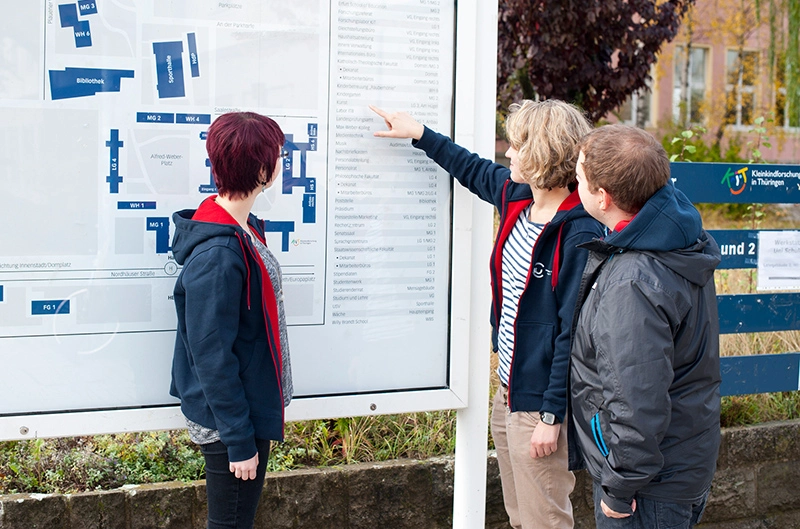Together with the Form & Fokus agency from Leipzig, a working group made up of representatives from various areas of the university under the leadership of Department 4: Facility Management is currently developing the new system and design and planning its implementation on the outside grounds and in the buildings.
"Our current signage system is clearly getting on in years and has many weak points," Bernd Sauerbrey explains the background to the innovations. For example, the signage is not sufficient in some places and is neither uniform nor logical in its structure. In addition, the system is not barrier-free (through tactile information) and is not bilingual. It is not only difficult for new students and employees to find their way around the campus, but suppliers also often have difficulty finding the right contact due to the large number of buildings that all operate under the address Nordhäuser Straße 63. "With the new guidance system, we want to eliminate all these deficits and position ourselves well for the future."
In future, all buildings will not only have their own delivery address, but will also be numbered counter-clockwise (C01 - C24 // C stands for campus). The buildings outside the campus will be labelled according to the street name and house number, e.g. N84 for the Willy Brandt School, P19 for Puschkinstraße, CG1 - CG6 for the Gotha campus, etc. "In doing so, we will of course retain proper names that are already established, in addition to the orientation number," explains Bernd Sauerbrey. "So the Max Kade House will remain the Max Kade House and would additionally receive the orientation number C09 according to the aforementioned scheme. The library will remain the library with the orientation number C16." The same applies to the Brandt School, the KIZ, the cafeteria and the Villa Martin. Link to the list with new building designations
The signage is also to be visually modernised. In line with the university's corporate design, metal stelae and panels are to be created that will guide visitors from the entrances to the campus via central crossroads to the buildings and then also within the buildings to their destination.
A corresponding handbook is to be created in 2022. The roll-out to the buildings on Campus and other locations of the University of Erfurt will take place successively.
"Establishing such a new guidance and orientation system is much more complex than it might seem at first glance," says Bernd Sauerbrey. We have to keep a very close eye in advance on where building designations, room numbers, etc. play a role. This starts with the signage, continues with web applications such as E.L.V.I.S. or our electronic business cards and signatures, inventory lists, asset accounting and ends with printed matter such as flyers, business cards, letterheads or campus plans. Our aim is to control or initiate the changes centrally as far as possible so that the individual departments in the faculties and institutions do not have to deal with unnecessary additional workloads. However, if their support is needed at one point or another, we will communicate this in good time and, above all, in a way that can be planned. This also applies to the timetable as a whole, which we will only be able to define more precisely once the handbook has been completed."
For the development of the new guidance and orientation system as well as the first implementation step, the state has provided a total of 200,000 euros as part of its "Inclusive Universities" programme.
The University of Erfurt bundles all information on the new guidance and orientation system on its website at: www.uni-erfurt.de/en/universitaet/aktuelles/meilensteine/guidance-system. The site will be successively expanded.


